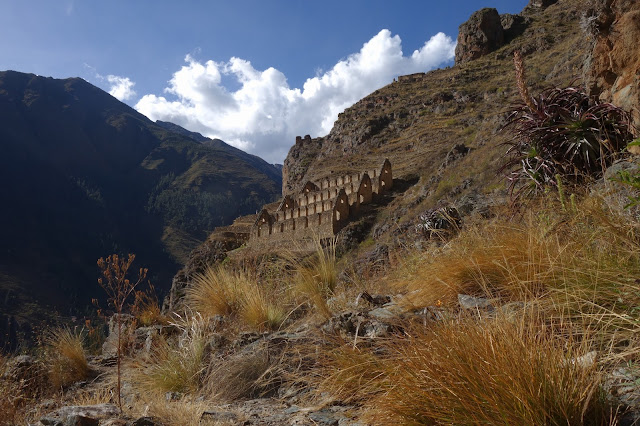Peru is full of immense history and rich culture. I feel lucky to have had the time to explore so many of the ruins that were left behind throughout the Sacred Valley region. When people think of Peru, often Machu Picchu is what comes to mind. However, that is not the only remnants of the ancient civilization in the area. After spending a few days in Cusco, we made our way to a much smaller town halfway between the city and Machu Picchu, called Ollantaytambo. While it is a bit touristy, it also has amazing charm. Nestled at the bottom of a canyon, it is surrounded by beautiful mountains covered with ancient terraces and buildings. It puts the cobblestone streets in Cusco to shame with no more than 5 or 6 square blocks made up of adobe and stones. A little plaza is in the middle of town where you can find a variety of craft shops and restaurants. Some of the locals were dressed in traditional brightly colored costume, while others were adorned in the typical dress we have seen all over the country. We spent two days wandering these streets and hiking the neighboring mountains even discovering that the there was the face of Wiracochan carved into the side of one of the mountains, which could be seen from the right angle at the edge of town.
Our fist day, we arrived mid afternoon via colectivo from Cusco. After spending about an hour finding a hotel and eating lunch, we decided to hike Pinkuylluna ruins. It took no more than a half hour, but it was straight up a cliffside with nothing but enormous inca steps and a questionable wooden railing. What we saw when we got up there, however, was an incredible view of the valley, the more famous Ollantaytambo ruins, and the town. Several large stone structures are built into the mountainside, with the same picturesque views from the windows.
The entire second day was spent exploring the Ollantaytambo ruins, residing right on the edge of town. They are enormous, which is why it took all day. Like Pinkuylluna, the buildings and terraces are built right into the mountainside. We climbed in wonder at the scale of the site,and at the top we discovered a small doorway with a trail leading even higher. With our adventurous spirit, how could we not follow it? We were awarded with more ruins and the most fantastic view of the whole area. Even better than the day before. We could see the valley split by the river and it's tributaries in several directions. Bright green patches of farmland was scattered throughout the region. Hiking the rest of the ruins, they were viewed in amazement with numerous carved fountains, giants stones, and scaling terraces. We went on a smaller afternoon hike across the Inca Bridge, which was nothing more than a modern footpath. However, it was definitely a pretty walk on the other side of the river. More terraces and more ruins, and a great view of the trains bound for Machu Picchu.
Our last day, we paid a taxi to takes us to some more of the famous sites nearby: Moray and Salinas de Maras. Moray was an impressive indentation with terraces designed for growing crops at different temperatures. It only took a few minutes to walk the rim and hike a trail toward the center. It rested on the edge of the same valley we had been staying in for the past few days. Fields of wheat and quinua are harvested here by hand with small scythes and shaggy donkeys. The more interesting of the two things we saw that day were the still active salt pools of the tiny town called Maras. This town has been dehydrating and harvesting salt from a natural spring for generations. There are hundreds of pools rolling down a narrow valley, contrasting a bright white against the green mountains nearby. It was a good end to our time in Ollantaytambo before the three days of long bus rides to Chile. This was well worth the side trip.
Ollantytambo, Peru
Hotels: 148 soles/night
Restaurants:
La Esquina
El Albergue
Transportation:
Colectivo to Ollantaytambo: 10 soles/ea
Taxi to Salinas and Moray: 140 soles
On foot
Activities:
Salinas de Maras: 10 soles/ea
Ollantaytambo Ruins (tourist ticket)
Moray (tourist ticket)













No comments:
Post a Comment